Interannual Relationship between ENSO and Atlantic Storm Track in Spring Modulated by the Atlantic Multidecadal Oscillation
Abstract
1. Introduction
2. Data and Methodology
2.1. Reanalysis Data and Methodology
2.2. Model Introduction
3. Results and Discussion
3.1. Result of Atmospheric Reanalysis
3.2. Results of Model Simulations
3.3. Summary and Directions of Future Work
4. Conclusions
Author Contributions
Funding
Conflicts of Interest
References
- Blackmon, M.L. A climatological spectral study of the 500 mb geopotential height of the northern hemisphere. J. Atmos. Sci. 1976, 33, 1607–1623. [Google Scholar] [CrossRef]
- Lau, N.C. Variability of the observed midlatitude storm tracks in relation to low-frequency changes in the circulation pattern. J. Atmos. Sci. 1988, 45, 2718–2743. [Google Scholar] [CrossRef]
- Chang, E.K.; Fu, Y. Interdecadal variations in Northern Hemisphere winter storm track intensity. J. Clim. 2002, 15, 642–658. [Google Scholar] [CrossRef]
- Jin, F.F. Eddy-induced instability for low-frequency variability. J. Atmos. Sci. 2010, 67, 1947–1964. [Google Scholar] [CrossRef]
- Kug, J.S.; Jin, F.F.; Park, J.; Ren, H.L.; Kang, I.S. A general rule for synoptic-eddy feedback onto low-frequency flow. Clim. Dyn. 2010, 35, 1011–1026. [Google Scholar] [CrossRef]
- Nakamura, H.; Izumi, T.; Sampe, T. Interannual and decadal modulations recently observed in the Pacific storm track activity and East Asian winter monsoon. J. Clim. 2002, 15, 1855–1874. [Google Scholar] [CrossRef]
- Nakamura, H. Midwinter suppression of baroclinic wave activity in the Pacific. J. Atmos. Sci. 1992, 49, 1629–1642. [Google Scholar] [CrossRef]
- Christoph, M.; Ulbrich, U.; Speth, P. Midwinter suppression of Northern Hemisphere storm track activity in the real atmosphere and in GCM experiments. J. Atmos. Sci. 1997, 54, 1589–1599. [Google Scholar] [CrossRef]
- Straus, D.M.; Shukla, J. Variations of midlatitude transient dynamics associated with ENSO. J. Atmos. Sci. 1997, 54, 777–790. [Google Scholar] [CrossRef]
- Zhang, Y.; Held, I.M. A linear stochastic model of a GCM’s midlatitude storm tracks. J. Atmos. Sci. 1999, 56, 3416–3435. [Google Scholar] [CrossRef]
- Geng, Q.; Sugi, M. Variability of the North Atlantic cyclone activity in winter analyzed from NCEP–NCAR reanalysis data. J. Clim. 2001, 14, 3863–3873. [Google Scholar] [CrossRef]
- Ebisuzaki, W.; Chelliah, M. ENSO and inter-decadal variability in storm tracks over North America and vicinity. In Proceedings of the 23d Annual Climate Diagnostics and Prediction Workshop, Miami, FL, USA, 26–30 October 1998. [Google Scholar]
- Graham, N.E.; Diaz, H.F. Evidence for intensification of North Pacific winter cyclones since 1948. Bull. Am. Meteorol. Soc. 2001, 82, 1869–1894. [Google Scholar] [CrossRef]
- Riviere, G.; Orlanski, I. Characteristics of the Atlantic storm-track eddy activity and its relation with the North Atlantic Oscillation. J. Atmos. Sci. 2007, 64, 241–266. [Google Scholar] [CrossRef]
- Nie, J.; Wang, P.; Yang, W.; Tan, B. Northern hemisphere storm tracks in strong AO anomaly winters. Atmos. Sci. Lett. 2008, 9, 153–159. [Google Scholar] [CrossRef]
- He, H.; Nie, J.; Tan, B. Northern hemisphere storm tracks in winter seasons and their energy budgets during the ENSO events. Acta Meteorol. Sin. 2009, 67, 210–217. [Google Scholar]
- Paredes, D.; Trigo, R.M.; Garcia-Herrera, R.; Trigo, I.F. Understanding precipitation changes in Iberia in early spring: Weather typing and storm-tracking approaches. J. Hydrometeorol. 2006, 7, 101–113. [Google Scholar] [CrossRef]
- Krishnamurthy, L.; Vecchi, G.A.; Msadek, R.; Wittenberg, A.; Delworth, T.L.; Zeng, F. The seasonality of the great plains low-level jet and ENSO relationship. J. Clim. 2005, 28, 4525–4544. [Google Scholar] [CrossRef]
- Muñoz, E.; Enfield, D.B. The boreal spring variability of the Intra-Americas low-level jet and its relation with precipitation and tornadoes in the eastern United States. Clim. Dyn. 2011, 36, 247–259. [Google Scholar] [CrossRef]
- Lee, S.-K.; Mapes, B.E.; Wang, C.; Enfield, D.B.; Weaver, S.J. Springtime ENSO phase evolution and its relation to rainfall in the continental U.S. Geophys. Res. Lett. 2014, 41, 1673–1680. [Google Scholar] [CrossRef]
- Zhang, Y.; Wallace, J.M.; Battisti, D.S. ENSO-like interdecadal variability: 1900–1993. J. Clim. 1997, 10, 1004–1020. [Google Scholar] [CrossRef]
- Delworth, T.L.; Mann, M.E. Observed and simulated multidecadal variability in the Northern Hemisphere. Clim. Dyn. 2000, 16, 661–676. [Google Scholar] [CrossRef]
- Kerr, R.A. A North Atlantic climate pacemaker for the centuries. Science 2000, 288, 1984–1985. [Google Scholar] [CrossRef] [PubMed]
- Sutton, R.T.; Hodson, D.L. Atlantic Ocean forcing of North American and European summer climate. Science 2005, 309, 115–118. [Google Scholar] [CrossRef] [PubMed]
- Zhou, Y.; Wu, Z. Possible impacts of mega-El Niño/Southern Oscillation and Atlantic Multidecadal Oscillation on Eurasian heatwave frequency variability. Q. J. R. Meteorol. Soc. 2016, 142, 1647–1661. [Google Scholar] [CrossRef]
- Dong, B.; Sutton, R.T.; Scaife, A.A. Multidecadal modulation of El Nino-Southern Oscillation (ENSO) variance by Atlantic Ocean sea surface temperatures. Geophys. Res. Lett. 2006, 33. [Google Scholar] [CrossRef]
- Kang, I.S.; No, H.H.; Kucharski, F. ENSO amplitude modulation associated with the mean SST changes in the tropical central Pacific induced by Atlantic multidecadal oscillation. J. Clim. 2014, 27, 7911–7920. [Google Scholar] [CrossRef]
- Timmermann, A.; Okumura, Y.; An, S.I.; Clement, A.; Dong, B.; Guilyardi, E.; Hu, A.; Jungclaus, J.H.; Renold, M.; Stocker, T.F.; et al. The influence of a weakening of the Atlantic meridional overturning circulation on ENSO. J. Clim. 2007, 20, 4899–4919. [Google Scholar] [CrossRef]
- Kalnay, E.; Kanamitsu, M.; Kistler, R.; Collins, W.; Deaven, D.; Gandin, L.; Zhu, Y. The NCEP/NCAR 40-year reanalysis project. Bull. Am. Meteorol. Soc. 1996, 77, 437–472. [Google Scholar] [CrossRef]
- Huang, B.; Thorne, P.W.; Banzon, V.F.; Boyer, T.; Chepurin, G.; Lawrimore, J.H.; Zhang, H.M. NOAA Extended Reconstructed Sea Surface Temperature (ERSST), Version 5; NOAA National Centers for Environmental Information: Boulder, CO, USA, 2017. [Google Scholar]
- Blackmon, M.L.; Wallace, J.M.; Lau, N.C.; Mullen, S.L. An observational study of the northern hemisphere wintertime circulation. J. Atmos. Sci. 1977, 34, 1040–1053. [Google Scholar] [CrossRef]
- Barnston, A.G.; Chelliah, M.; Goldenberg, S.B. Documentation of a highly ENSO-related SST region in the Equatorial Pacific. Atmos.-Ocean 1997, 35, 367–383. [Google Scholar] [CrossRef]
- Enfield, D.B.; Mestas-Nunez, A.M.; Trimble, P.J. The Atlantic Multidecadal Oscillation and its relationship to rainfall and river flows in the continental U.S. Geophys. Res. Lett. 2001, 28, 2077–2080. [Google Scholar] [CrossRef]
- Duchon, C.E. Lanczos filtering in one and two dimensions. J. Appl. Meteor. 1979, 18, 1016–1022. [Google Scholar] [CrossRef]
- Duchon, C.; Hale, R. Time Series Analysis in Meteorology and Climatology: An Introduction; John Wiley & Sons: Hoboken, NJ, USA, 2012; Volume 7. [Google Scholar]
- Yao, J.X.; Li-Ping, L.I.; Luo, X.; Yang, W.; Wang, P.X. Lanczos filter suitable for filtering quasi-two-week and quasi-one-month oscillations and its applications. Trans. Atmos. Sci. 2012, 35, 221–228. [Google Scholar]
- Anderson, D.; Hodges, K.I.; Hoskins, B.J. Sensitivity of feature-based analysis methods of storm tracks to the form of background field removal. Mon. Weather Rev. 2003, 131, 565–573. [Google Scholar] [CrossRef]
- Woolnough, S.J.; Slingo, J.M.; Hoskins, B.J. The relationship between convection and sea surface temperature on intraseasonal timescales. J. Clim. 2000, 13, 2086–2104. [Google Scholar] [CrossRef]
- Lee, S. Barotropic effects on atmospheric storm tracks. J. Atmos. Sci. 2000, 57, 1420–1435. [Google Scholar] [CrossRef]
- Lindzen, R.S.; Farrell, B. A simple approximate result for the maximum growth rate of baroclinic instabilities. J. Atmos. Sci. 1980, 37, 1648–1654. [Google Scholar] [CrossRef]
- Cai, M.; Yang, S.; Dool, H.M.V.D.; Kousky, V.E. Dynamical implications of the orientation of atmospheric eddies: A local energetics perspective. Tellus A 2007, 59, 127–140. [Google Scholar] [CrossRef]
- Takaya, K.; Nakamura, H. A formulation of a phase-independent wave-activity flux for stationary and migratory quasigeostrophic eddies on a zonally varying basic flow. J. Atmos. Sci. 2001, 58, 608–627. [Google Scholar] [CrossRef]
- Neale, R.B.; Chen, C.C.; Gettelman, A.; Lauritzen, P.H.; Park, S.; Williamson, D.L.; Marsh, D.; Liu, X.; Conley, A.J.; Taylor, M.A.; et al. Description of the NCAR Community Atmosphere Model (CAM 5.0); NCAR Tech. Note NCAR/TN-486+ STR; NCAR: Boulder, CO, USA, 2010. [Google Scholar]
- Ruprich-Robert, Y.; Msadek, R.; Castruccio, F.; Yeager, S.; Delworth, T.; Danabasoglu, G. Assessing the climate impacts of the observed Atlantic multidecadal variability using the GFDL CM2. 1 and NCAR CESM1 global coupled models. J. Clim. 2017, 30, 2785–2810. [Google Scholar] [CrossRef]
- Quadrelli, R.; Bretherton, C.S.; Wallace, J.M. On Sampling Errors in Empirical Orthogonal Functions. J. Clim. 2005, 18, 3704–3710. [Google Scholar] [CrossRef]
- North, G.R.; Bell, T.L.; Cahalan, R.F.; Moeng, F.J. Sampling errors in the estimation of empirical orthogonal functions. Mon. Weather Rev. 1982, 110, 699–706. [Google Scholar] [CrossRef]
- Lee, S.S.; Lee, J.Y.; Wang, B.; Ha, K.J.; Heo, K.Y.; Jin, F.F.; Straus, D.M.; Shukla, J. Interdecadal changes in the storm track activity over the North Pacific and North Atlantic. Clim. Dyn. 2012, 39, 313–327. [Google Scholar] [CrossRef]
- Metz, W. Low-frequency anomalies of atmospheric flow and the effects of cyclone-scale eddies: A canonical correlation analysis. J. Atmos. Sci. 1989, 46, 1026–1041. [Google Scholar] [CrossRef]
- Penny, S.M.; Battisti, D.S.; Roe, G.H. Examining mechanisms of variability within the Pacific storm track: Upstream seeding and jet-core strength. J. Clim. 2013, 26, 5242–5259. [Google Scholar] [CrossRef]
- Pinto, J.G.; Reyers, M.; Ulbrich, U. The variable link between PNA and NAO in observations and in multi-century CGCM simulations. Clim. Dyn. 2011, 36, 337–354. [Google Scholar] [CrossRef]
- Hoskins, B.J.; Valdes, P.J. On the existence of storm-tracks. J. Atmos. Sci. 1990, 47, 1854–1864. [Google Scholar] [CrossRef]
- Deng, J.; Xu, H.; Ma, H.; Jiang, Z. Numerical study of the effect of anthropogenic aerosols on spring persistent rain over eastern China. J. Meteor. Res. 2014, 28, 341–353. [Google Scholar] [CrossRef]
- Zhang, L.; Xu, H.; Shi, N.; Deng, J. Responses of the East Asian jet stream to the North Pacific subtropical front in spring. Adv. Atmos. Sci. 2017, 34, 144–156. [Google Scholar] [CrossRef]
- Saravanan, R.; Chang, P. Interaction between tropical Atlantic variability and El Nino–Southern Oscillation. J. Clim. 2000, 13, 2177–2194. [Google Scholar] [CrossRef]
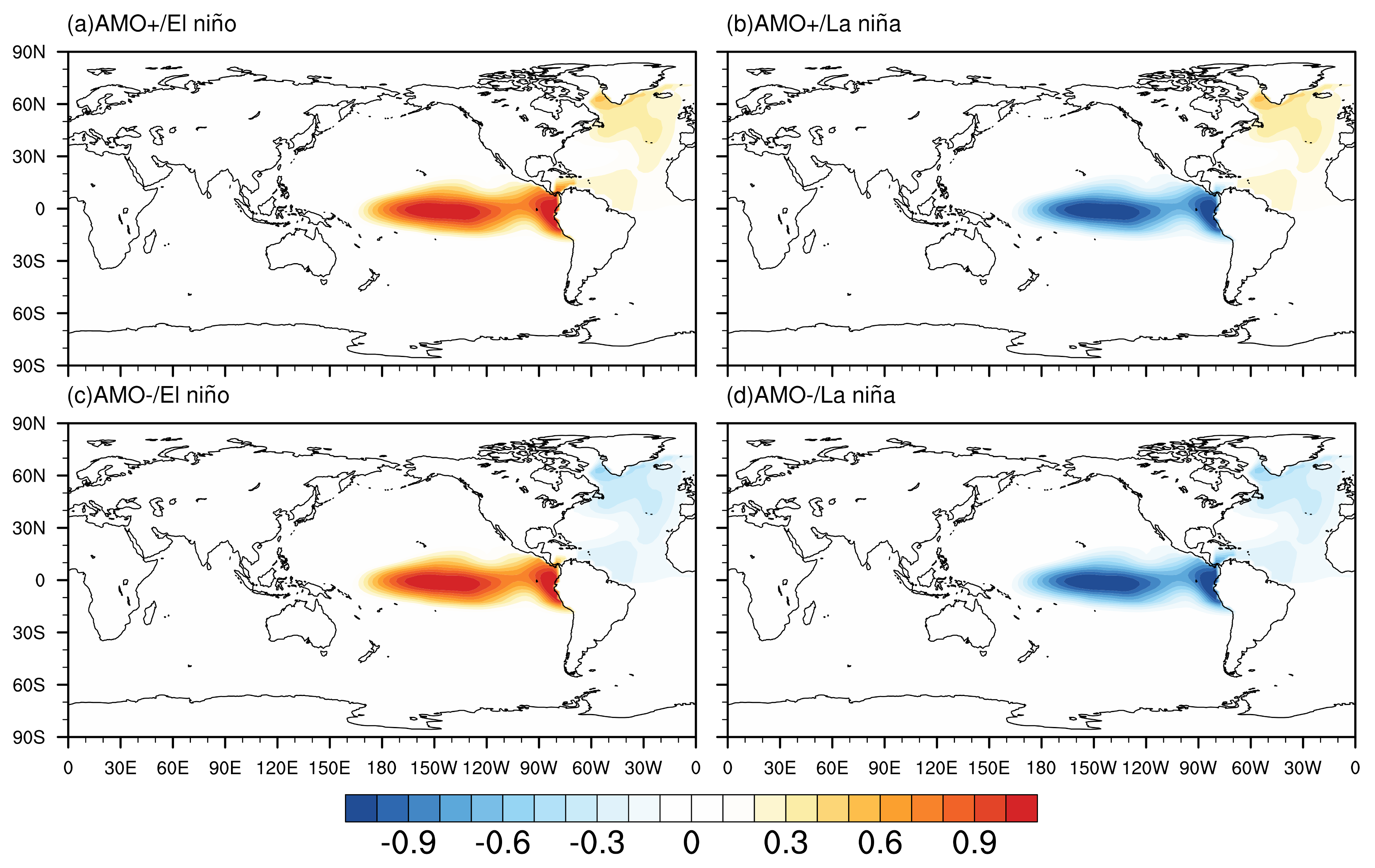
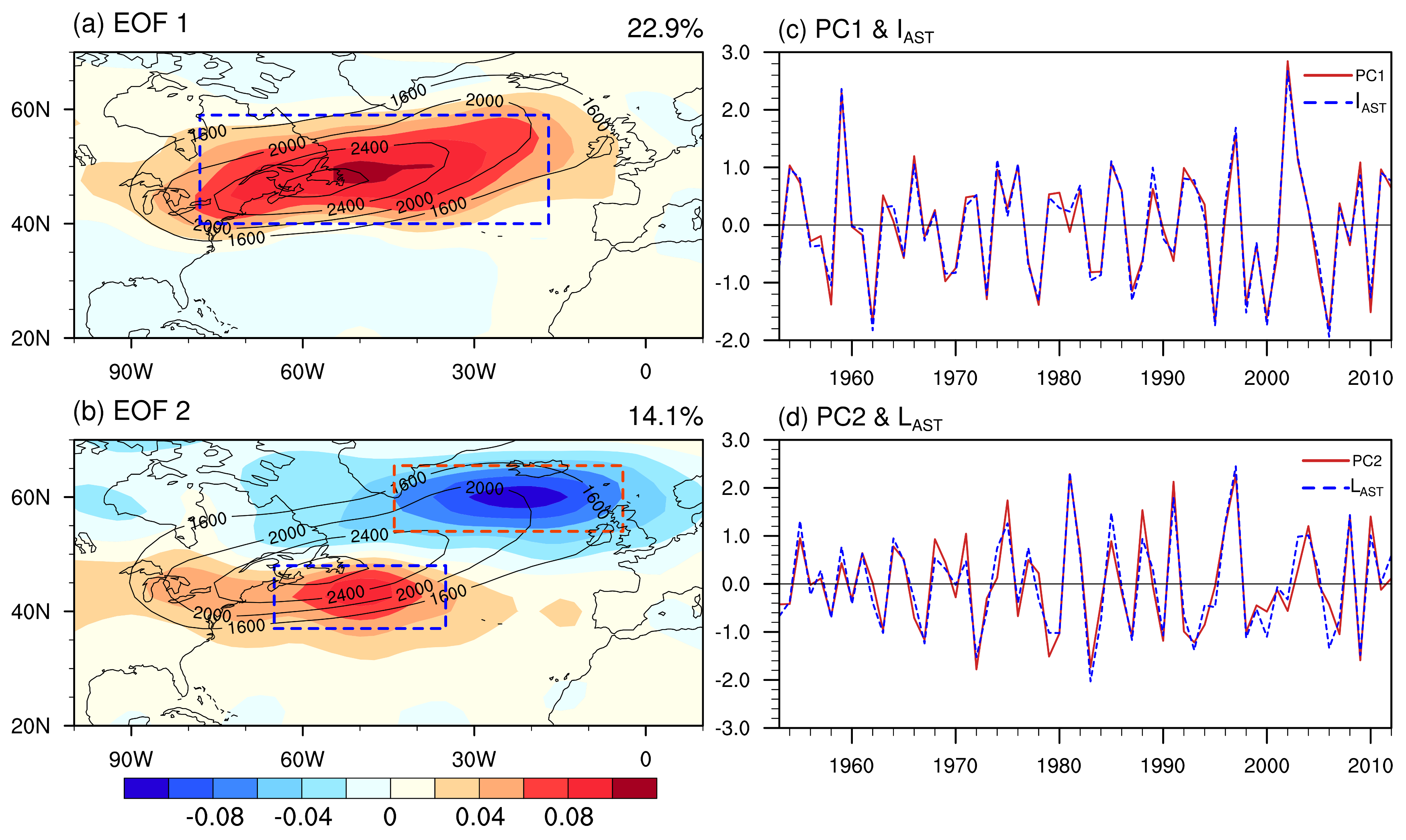
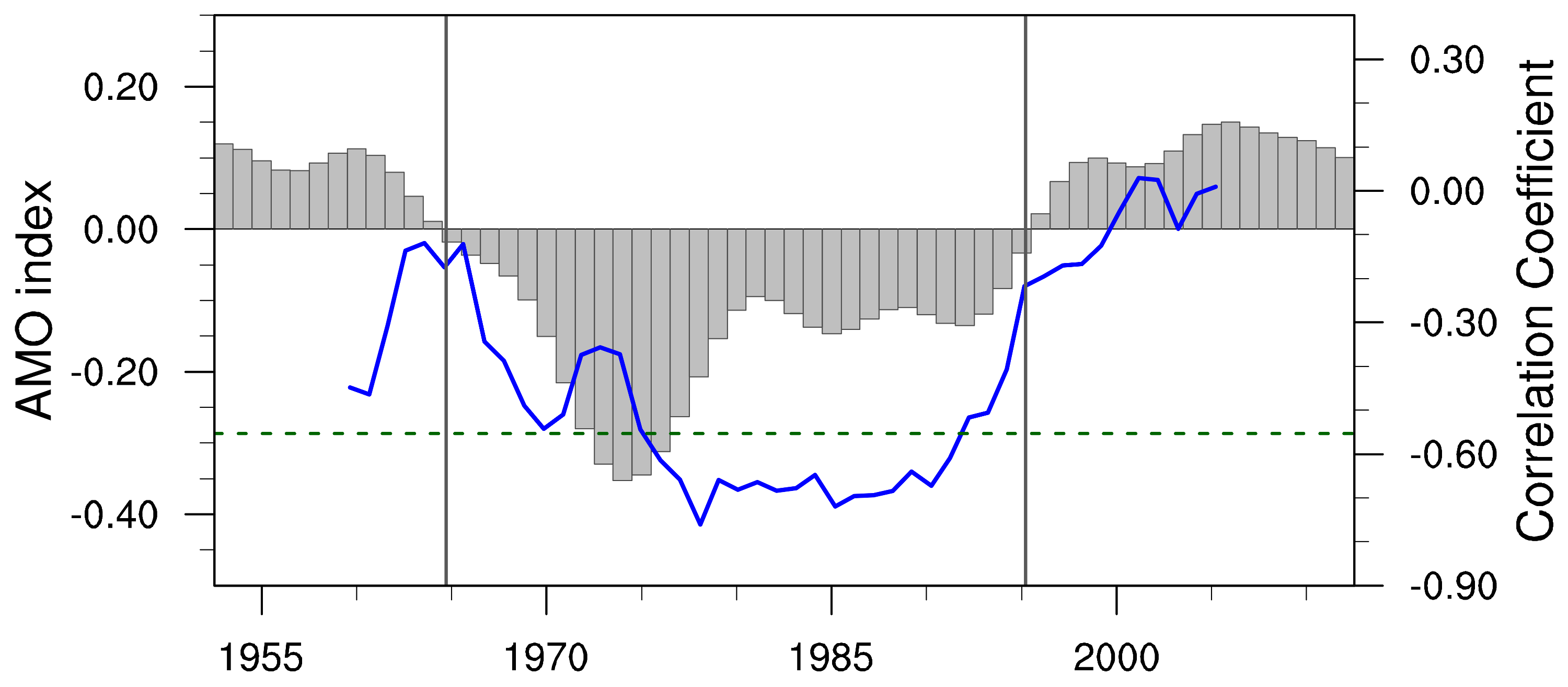

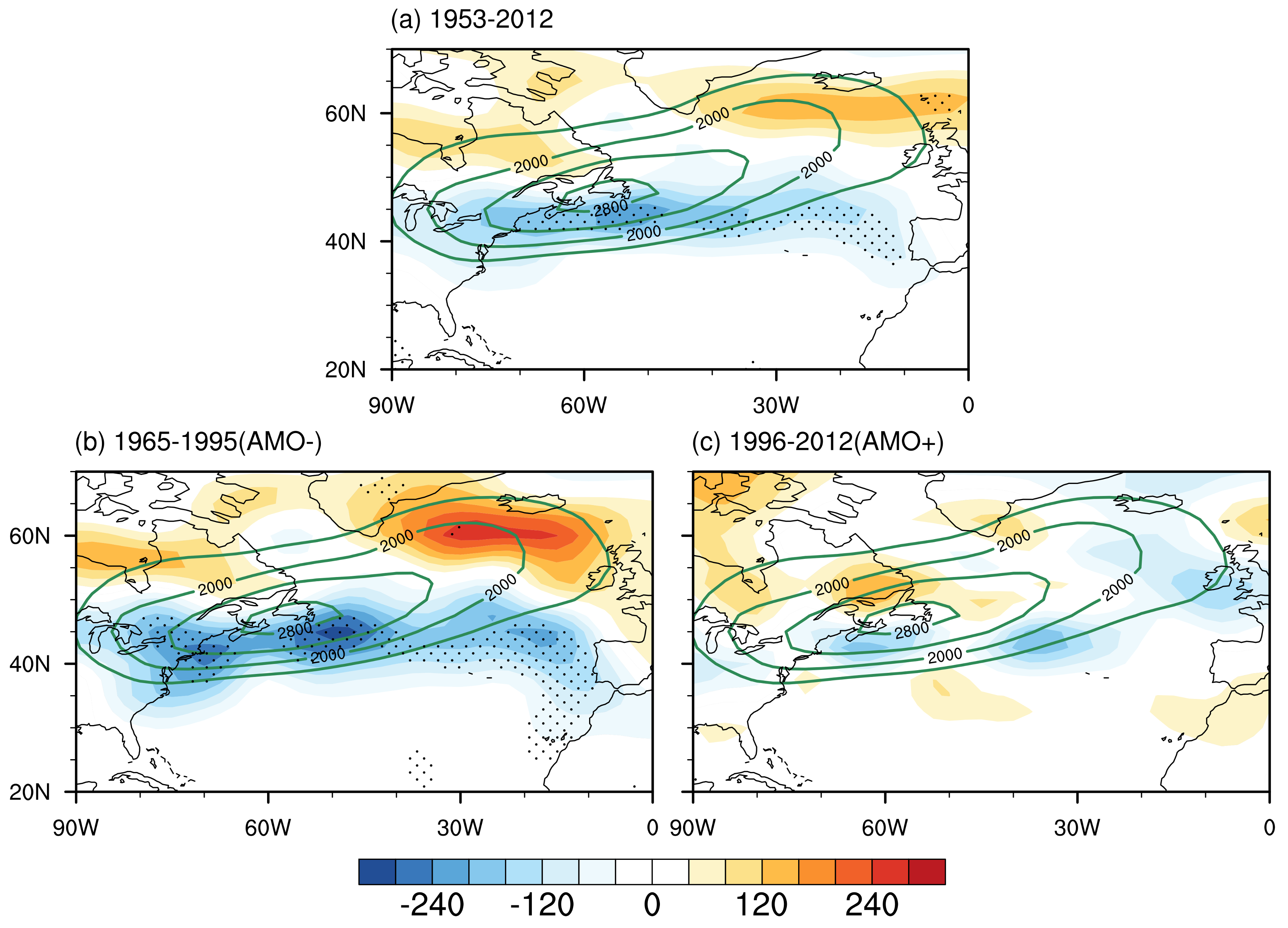
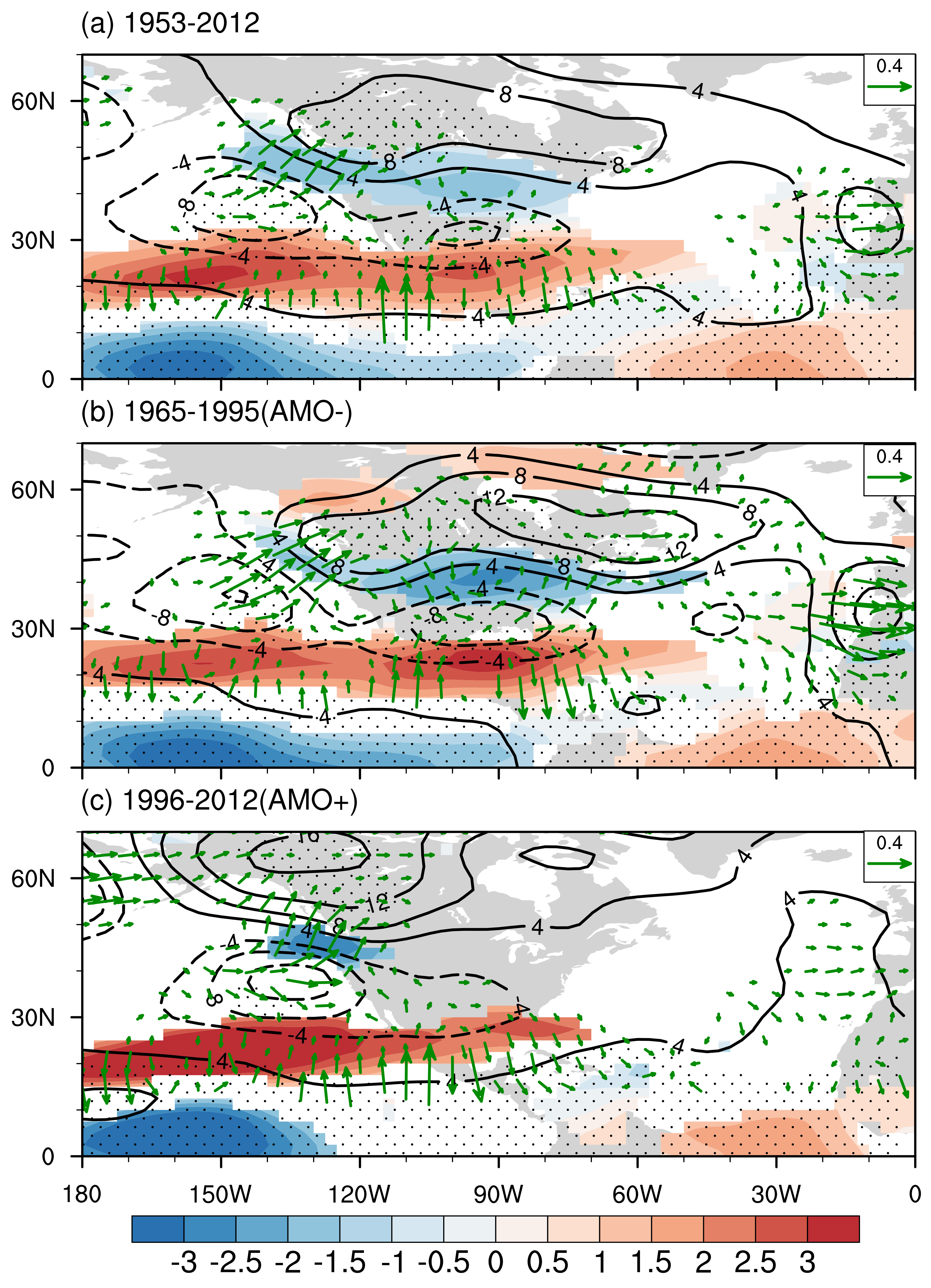
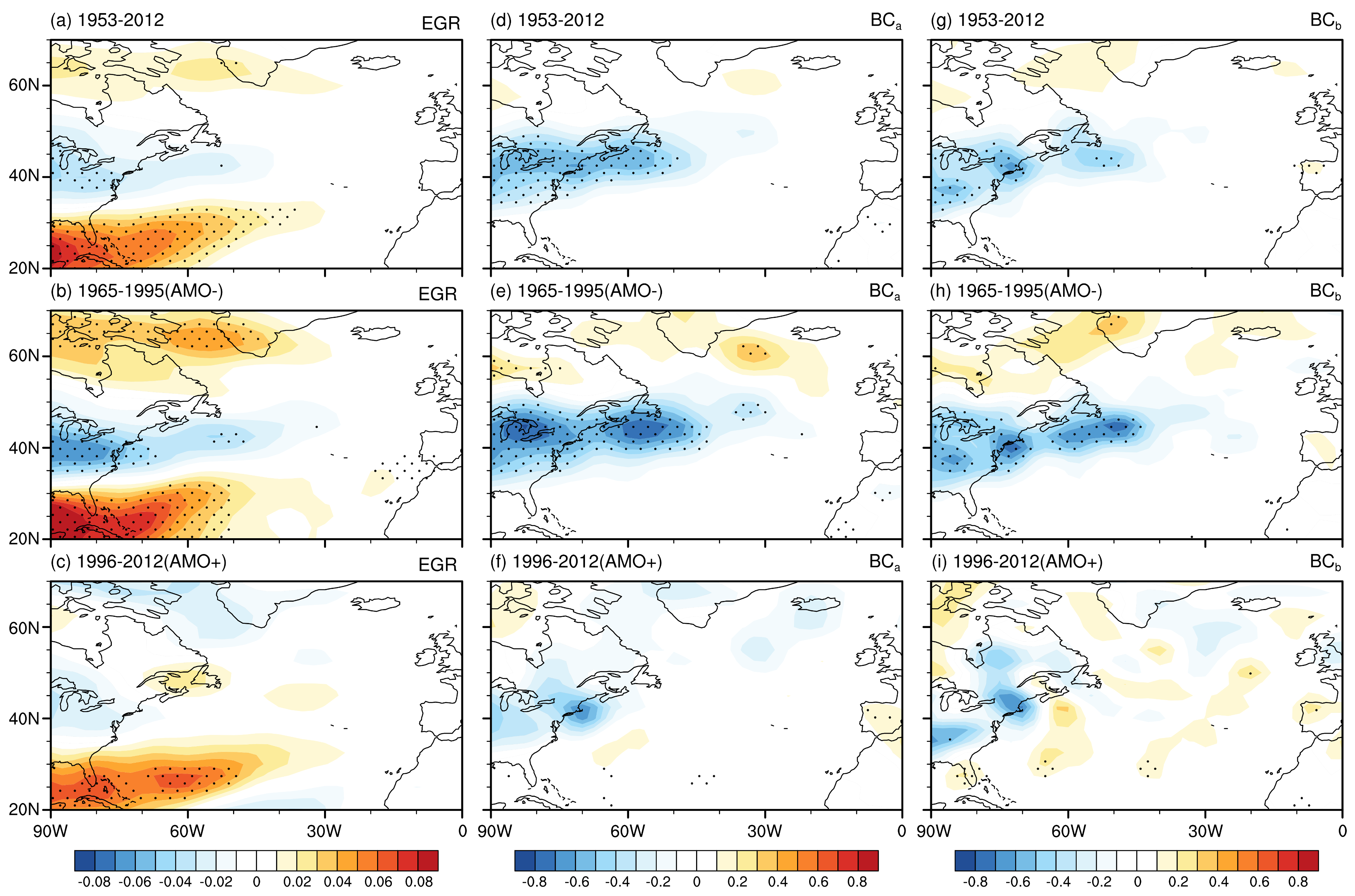

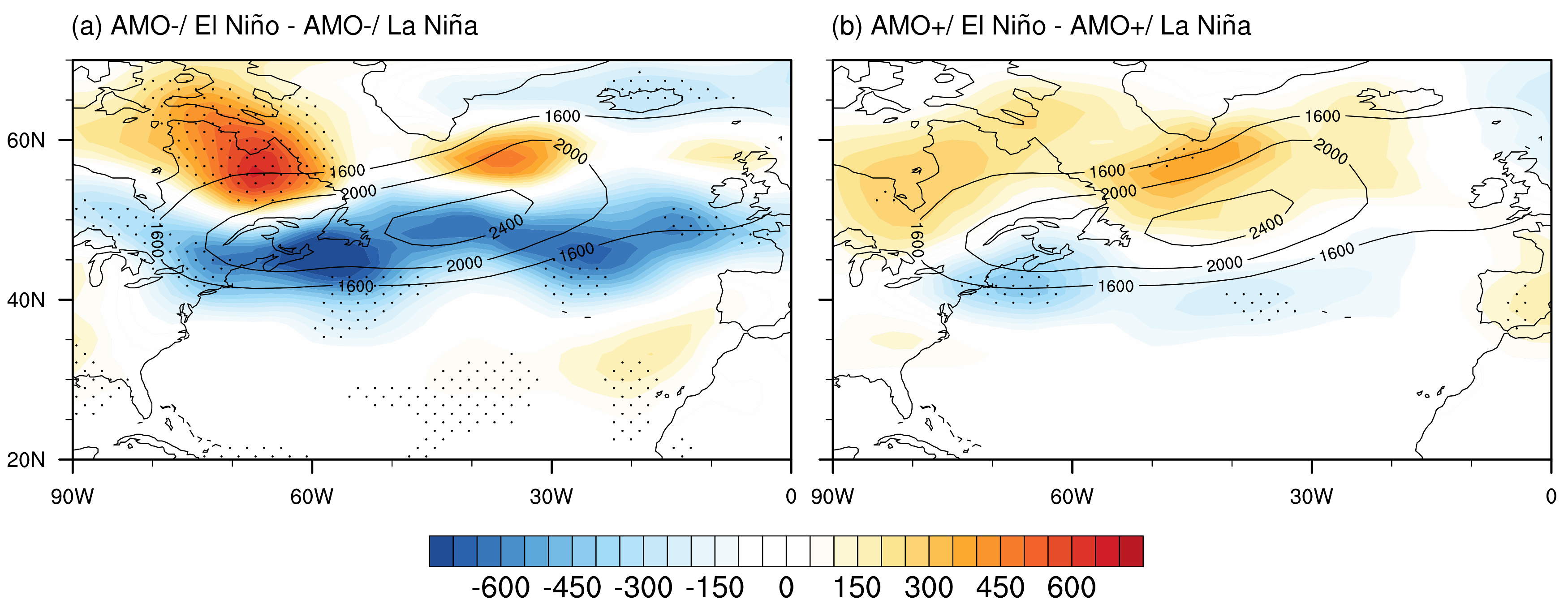
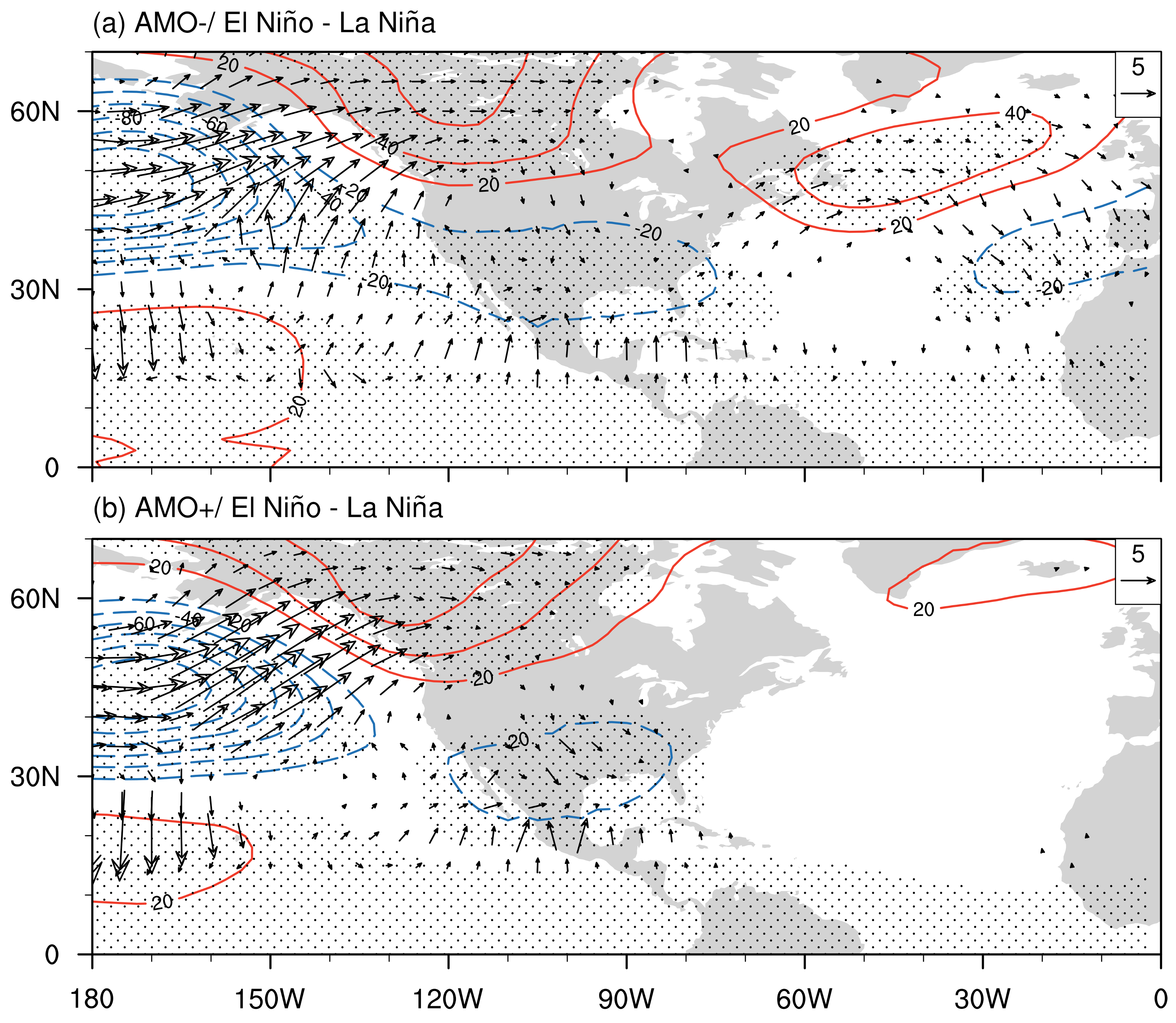
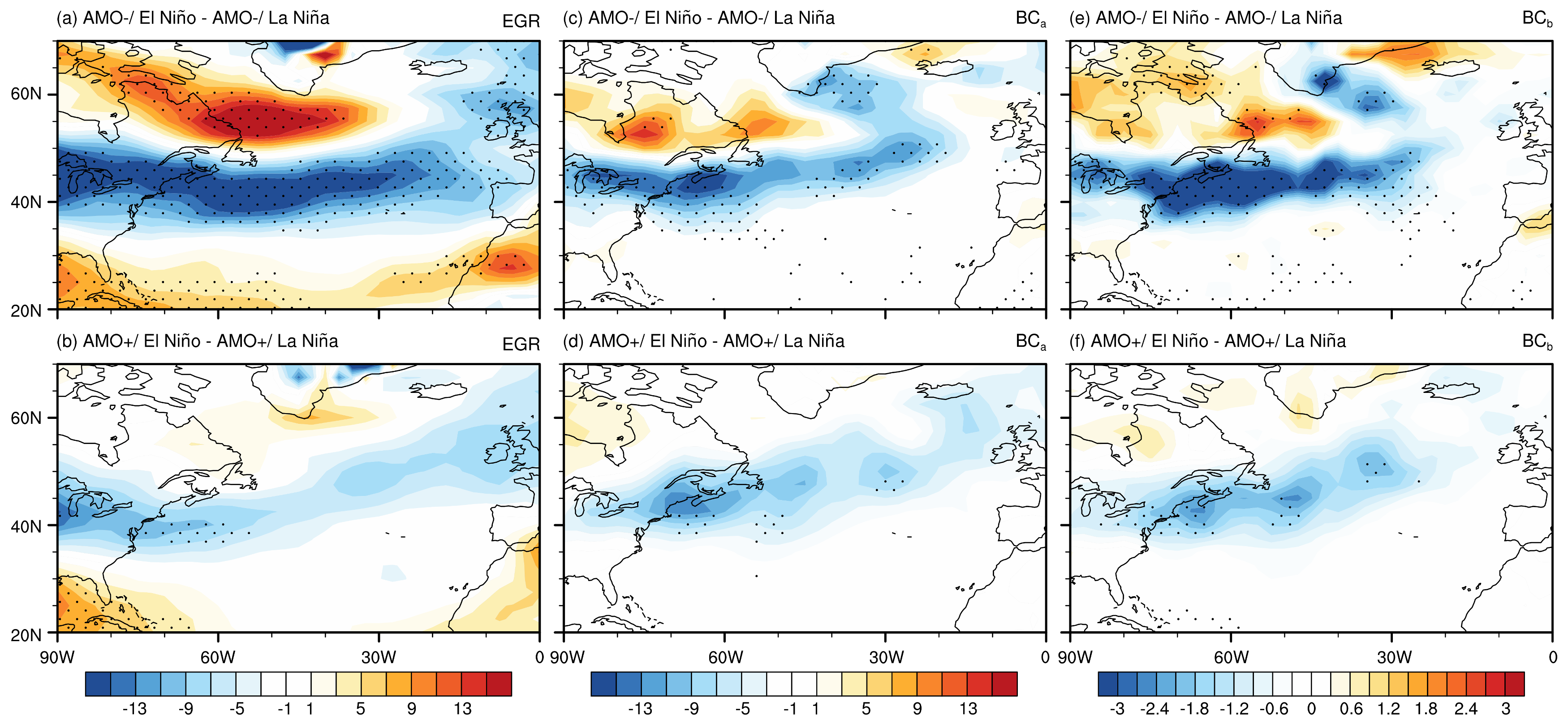
| Experiments | Description of the SST Perturbation |
|---|---|
| AMO+/El Niño | Positive SST anomalies (SSTA) regressed onto the AMO index are imposed over the North Atlantic (70° W–0, 0–70° N), and positive SSTA regressed onto the Niño3.4 index are also imposed over the tropical Pacific (170° E–75° W, 20° S–20° N) |
| AMO+/La Niña | Same as in AMO+/El Niño, but with negative SSTA imposed over the tropical Pacific |
| AMO−/El Niño | Same as in AMO+/El Niño, but with negative SSTA imposed over the North Atlantic |
| AMO−/La Niña | Same as in AMO−/El Niño, but with negative SSTA imposed over the tropical Pacific |
© 2018 by the authors. Licensee MDPI, Basel, Switzerland. This article is an open access article distributed under the terms and conditions of the Creative Commons Attribution (CC BY) license (http://creativecommons.org/licenses/by/4.0/).
Share and Cite
Liao, C.; Xu, H.; Deng, J.; Zhang, L. Interannual Relationship between ENSO and Atlantic Storm Track in Spring Modulated by the Atlantic Multidecadal Oscillation. Atmosphere 2018, 9, 419. https://doi.org/10.3390/atmos9110419
Liao C, Xu H, Deng J, Zhang L. Interannual Relationship between ENSO and Atlantic Storm Track in Spring Modulated by the Atlantic Multidecadal Oscillation. Atmosphere. 2018; 9(11):419. https://doi.org/10.3390/atmos9110419
Chicago/Turabian StyleLiao, Chenfei, Haiming Xu, Jiechun Deng, and Leying Zhang. 2018. "Interannual Relationship between ENSO and Atlantic Storm Track in Spring Modulated by the Atlantic Multidecadal Oscillation" Atmosphere 9, no. 11: 419. https://doi.org/10.3390/atmos9110419
APA StyleLiao, C., Xu, H., Deng, J., & Zhang, L. (2018). Interannual Relationship between ENSO and Atlantic Storm Track in Spring Modulated by the Atlantic Multidecadal Oscillation. Atmosphere, 9(11), 419. https://doi.org/10.3390/atmos9110419





